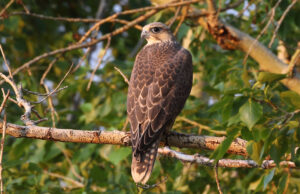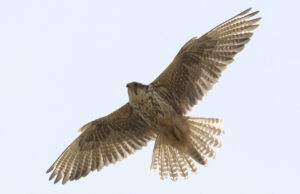Third International Scientific and Practical Conference “Eagles of the Palearctic: Study and Conservation”
Raptors Conservation. Suppl. 2. Proceedings of Conferences
Status and Conservation of the Saker Falcon in Austria
Hohenegger J.A. (BirdLife Austria, Vienna, Austria)
Donnerbaum K.E., Zink R. (Austrian Ornithological Center, Vienna, Austria)
Berg H.-M. (Natural History Museum, Vienna, Austria)
Contact:
Johannes Hohenegger johannes.hohenegger@birdlife.at
Karin Donnerbaum karin.donnerbaum@vetmeduni.ac.at
Richard Zink richard.zink@vetmeduni.ac.at
Hans-Martin Berg hans-martin.berg@nhm-wien.ac.at
Recommended citation: Hohenegger J.A., Donnerbaum K.E., Zink R., Berg H.-M. Status and Conservation of the Saker Falcon in Austria. – Raptors Conservation. 2023. S2: 443–446. DOI: 10.19074/1814- 8654-2023-2-443-446 URL: http://rrrcn.ru/en/archives/35214
The short lecture summarizes the results of a conservation program for the Saker Falcon (Falco cherrug) in Austria for the years 2011–2022. The species reaches the western limit of its global distribution in Austria. Therefore, it is restricted to the east of the country and naturally a scarce species with high conservation concern. When Saker Falcons showed a growing tendency to nest in abandoned corvid nests on high-voltage power lines from the late 1990s on, the Austrian Ornithological Center (AOC, formerly Vetmeduni) and Austrian Power Grid (APG) supported the species from 2007 onward by providing artificial nesting sites on several powerlines within the known breeding range. AOC and BirdLife Austria have been conducting a joint nation-wide conservation program since 2011. This includes a yearly survey of all known breeding sites, ringing Saker chicks (carried out since 2015), and monitoring reasons for mortality and potential threats. Within the surveyed period (2011–2022), the species showed a clear increase in breeding pairs, successfully breeding pairs, and fledged young per breeding attempt. The clearly positive trend in all population parameters surveyed may be attributed to several factors such as nest site availability, nest site selection, and changing weather conditions. The number of artificial nesting sites has been increased; while the conservation program began with the installation of breeding platforms, from 2014 on all additionally installed artificial aids have been nest boxes. Since then, we have observed a steep increase in the number of pairs breeding in these boxes, which most probably contributed to the population growth as well as the rising proportion of successfully breeding pairs.
Despite the prospering population, the breeding range of the species has not increased significantly and is still limited to the low-lying Pannonian region in eastern Austria. Contrary to other recovering raptor species in the region (e.g. Imperial Eagle Aquila heliaca and Red Kite Milvus milvus), no clear westward expansion of the Saker’s range could be observed. Rather a rising concentration of pairs in the longknown range led to population growth. Interestingly, the most westerly historic breeding sites on the edge of the Alps and of the Bohemian Massif have been abandoned for decades.
The Pannonian basin hosts a single transboundary population of Saker Falcon and the birds move regularly between the different countries. This is also true for the Austrian part of the range: Most recoveries of banded Austrian birds have been made abroad and prove the exchange of birds between Austria, Slovakia, Hungary, and Serbia. Other interesting records of Austrian ringed birds comprise a recovery from Algeria and one from Poland.
Currently, we know of no threats impacting the Saker Falcon in Austria on the population level. Nevertheless, our results show some potential threats that must be closely monitored in the future to secure the species. Proven, human-caused mortality reasons comprise collisions with power line infrastructure, wind power plants and vehicles, electrocution, and deliberate shooting. Intentional as well as unintentional poisoning is highly likely to occur at least occasionally but has not yet been investigated thoroughly.
Our results give rise to several research topics that should be considered in the future, including the influence of wind power development, possible nest site competition between Eagle Owl (Bubo bubo) or Northern Raven (Corvus corax) and Saker Falcon or the effects of sublethal rodenticide poisoning on the bird’s health and mortality risk.


